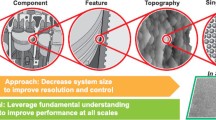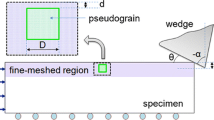Abstract
Using in situ, high-speed imaging of a hard wedge sliding against pure aluminum, and image analysis by particle image velocimetry, the deformation field in sliding is mapped at high resolution. This model system is representative of asperity contacts on engineered surfaces and die–workpiece contacts in deformation and machining processes. It is shown that large, uniform plastic strains of 1–5 can be imposed at the Al surface, up to depths of 500 μm, under suitable sliding conditions. The spatial strain and strain rate distributions are significantly influenced by the initial deformation state of the Al, e.g., extent of work hardening, and sliding incidence angle. Uniform straining occurs only under conditions of steady laminar flow in the metal. Large pre-strains and higher sliding angles promote breakdown in laminar flow due to surface fold formation or flow localization in the form of shear bands, thus imposing limits on uniform straining by sliding. Avoidance of unsteady sliding conditions, and selection of parameters like sliding angle, thus provides a way to control the deformation field. Key characteristics of the sliding deformation such as strain and strain rate, laminar flow, folding and prow formation are well predicted by finite element simulation. The deformation field provides a quantitative basis for interpreting wear particle formation. Implications for engineering functionally graded surfaces, sliding wear and ductile failure in metals are discussed.










Similar content being viewed by others
References
Backofen, W.A.: Deformation Processing. Addison-Wesley, Reading (1972)
Hughes, D.A., Hansen, N.: Graded nanostructures produced by sliding and exhibiting universal behavior. Phys. Rev. Lett. 87, 135503 (2001)
Fang, T.H., Li, W.L., Tao, N.R., Lu, K.: Revealing extraordinary intrinsic tensile plasticity in gradient nano-grained copper. Science 331, 1587–1590 (2011)
Guo, Y., Saldana, C., Compton, W.D., Chandrasekar, S.: Controlling deformation and microstructure on machined surfaces. Acta Mater. 59, 4538–4547 (2011)
Bowden, F.P., Tabor, D.: The Friction and Lubrication of Solids, Chapter 5. Clarendon Press, Oxford (1954)
Hutchings, I.M.: Tribology: Friction and Wear of Engineering Materials. Butterworth Heinemann, Oxford (2003)
Zum Gahr, K.H.: Microstructure and Wear of Materials. Elsevier, Amsterdam (1987)
Suh, N.P.: An overview of the delamination theory of wear. Wear 44, 1–16 (1977)
Rigney, D.A., Hirth, J.P.: Plastic deformation and sliding friction of metals. Wear 53, 345–370 (1979)
Kopalinsky, E.M., Oxley, P.L.B.: Explaining the mechanics of metallic sliding friction and wear in terms of slipline field models of asperity deformation. Wear 190, 145–154 (1995)
Black, A.J., Kopalinsky, E.M., Oxley, P.L.B.: Asperity deformation models for explaining the mechanisms involved in metallic sliding friction and wear—a review. Proc. Inst. Mech. Eng. Part C: J. Mech. Eng. Sci. 207, 335–353 (1993)
Dautzenberg, J.H., Zaat, J.H.: Quantitative determination of deformation by sliding wear. Wear 23, 9–19 (1973)
Moore, M.A., Douthwaite, R.M.: Plastic deformation below worn surfaces. Metall. Trans. A 12, 1833–1839 (1976)
Heilmann, P., Clark, W.A.T., Rigney, D.A.: Orientation determination of subsurface cells generated by sliding. Acta Metall. 31, 1293–1305 (1983)
Hughes, D.A., Hansen, N.: Deformation structures developing on fine scales. Phil. Mag. 83, 3871–3893 (2003)
Schey, J.A.: Tribology in Metalworking. American Society of Metals, Metals Park (1983)
Sundaram, N.K., Guo, Y., Chandrasekar, S.: Mesoscale folding, instability, and disruption of laminar flow in metal surfaces. Phys. Rev. Lett. 109, 106001 (2012)
Mahato, A., Guo, Y., Sundaram, N.K., Chandrasekar, S.: Surface folding in metals: a mechanism for delamination wear in sliding. Proc. R. Soc. A 470, 20140297 (2014)
Tabor, D.: Wear—a critical synoptic view. In: Glaeser, W.A., Ludema, K.C., Rhee, S.K. (eds.) Wear of Materials, pp. 1–11. The American Society of Mechanical Engineers, New York (1977)
Samuels, L.E., Doyle, E.D., Turley, D.M.: Sliding wear mechanisms. In: Rigney, D.A. (ed.) Fundamentals of Friction and Wear of Materials, pp. 13–14. American Society for Metals, Materials Park (1981)
Johnson, K.L.: Contact mechanics and the wear of metals. Wear 190, 162–170 (1995)
Kapoor, A., Williams, J.A., Johnson, K.L.: The steady state sliding of rough surfaces. Wear 175(1), 81–92 (1994)
Torrance, A.A.: The influence of surface deformation on mechanical wear. Wear 200, 45–54 (1996)
Guo, Y., Compton, W.D., Chandrasekar, S.: In situ analysis of flow dynamics and deformation fields in cutting and sliding of metals. Proc. R. Soc. A 471, 20150194 (2015)
Metals Handbook: Vol. 2—Properties and Selection: Nonferrous Alloys and Special-Purpose Materials, 10th edn. ASM International, Materials Park (1990)
Gnanamanickam, E.P., Lee, S., Sullivan, J.P., Chandrasekar, S.: Direct measurement of large-strain deformation fields by particle tracking. Meas. Sci. Technol. 20, 095710 (2009)
Adrian, R.J.: Particle-imaging techniques for experimental fluid mechanics. Annu. Rev. Fluid Mech. 23, 261–304 (1991)
Raffel, M., Willert, C.E., Wereley, S.T., Kompenhans, J.: Particle image velocimetry: a practical guide, 2nd edn. Springer, Berlin (2007)
Samuels, L.E.: Metallographic polishing by mechanical methods, 3rd edn. American Society for Metals, Materials Park (1982)
Johnson, R.W., Rowe, G.W.: Bulge formation in strip drawing with light reductions in area. Proc. Instn. Mech. Engrs. 182, 521–530 (1967)
Rowe, G.W., Wetton, A.G.: A simple correlation between deformation in some sliding-wear and metal-working processes. Wear 8, 448–454 (1965)
Rigney, D.A., Karthikeyan, S.: The evolution of tribomaterial during sliding: a brief introduction. Tribol. Lett. 39(1), 3–7 (2010)
Kuo, S.M., Rigney, D.A.: Sliding behavior of aluminum. Mater. Sci. Eng. A 157, 131–143 (1992)
Stobbs, W.M., Kallend, J.S., Williams, J.A.: Deformation behaviour of copper in ultramicrotomy. Acta Metall. 24, 1083–1093 (1976)
Hatherly, M., Malin, A.S.: Shear bands in deformed metals. Scripta Metall. 18, 449–454 (1984)
Mahato, A., Verma, N., Jayaram, V., Biswas, S.K.: Severe wear of a near-eutectic aluminium–silicon alloy. Acta Mater. 59, 6069–6082 (2011)
Cockcroft, M.G., Latham, D.J.: Ductility and the workability of metals. J. Inst. Met. 96, 33–39 (1968)
Bao, Y., Wierzbicki, T.: A comparative study on various ductile crack formation criteria. J. Eng. Mater. Technol. 126, 314–324 (2004)
Armstrong, P.E., Hockett, J.E., Sherby, O.D.: Large strain multidirectional deformation of 1100 aluminum at 300 K. J. Mech. Phys. Solids 30, 37–58 (1982)
Lindholm, U.S.: Some experiments with the split Hopkinson pressure bar. J. Mech. Phys. Solids 12, 317–335 (1964)
Acknowledgments
Research at Purdue was supported in part by NSF GOALI Grant CMMI 1234961 and US Army Research Office Award W911NF-15-1-0591. Research at the Indian Institute of Science (IISc) was supported in part by an Indian Space Research Organisation (ISRO)/IISc Space Technology Cell research Grant ISTC/CCE/NKS/335.
Author information
Authors and Affiliations
Corresponding author
Appendix: Finite Element Analysis
Appendix: Finite Element Analysis
As seen in the experiments, the initial WP deformation state has a major influence on the subsequent sliding-induced deformation. This aspect had been neglected in prior analyses of sliding deformation using slipline field (SLF) [10, 11, 21–23, 30, 31] and FEA [23]. To address this deficiency, a specially devised 2-pass sliding process with WPs of ɛ o = 0, 0.4 was analyzed. The simulation of the first pass provided the strain, strain rate and other flow details for ɛ o = 0, 0.4. Since the surface strain imposed in the first sliding pass in these two WPs was ~1, the simulation of the second pass provided deformation data for ɛ o in the 1–2 range. In the analysis, the cumulative surface strain at the end of the first sliding pass was used as the ɛ o for the second pass. Thus the entire range of ɛ o used in the experiments (0 to 2) was covered in the simulation.
ABAQUS/EXPLICIT solver was used to simulate the sliding-induced deformation in the aluminum 1100-0. The wedges were modeled as stiff elastic bodies with θ = 20°, 25°. In the interest of computational efficiency, the 2-pass sliding was simulated in a single FEA pass by having two wedges, separated by a horizontal distance of 4.25 mm, traverse the WP surface in sequence. About 120,000 four-nodded, plane strain elements with reduced integration (CPE4R) and aspect ratio of 0.7 were used to mesh the specimens. The element size is smallest in a fine-meshed region close to the WP surface. This region consists of 2250 elements along the length of the WP, and 48 elements into the depth, with an element size of 10.16 µm. The wedges were held fixed in the horizontal direction, while the WP was pushed against the wedges with a velocity of 5 mm/s. An initial depth h o = 100 µm was used for the leading wedge. To better replicate experiment conditions, where the compliance of the wedge-tool holder gradually relaxes the initial h o into a lower value, the leading wedge was provided with a programmed upward motion. This resulted in gradual retraction of the leading wedge after the formation of a leading prow of approximately the height h p observed in the experiments. The trailing wedge was held fixed, providing an effective h o as selected in the second sliding pass of the experiments.
The annealed Al (ɛ o = 0) was modeled as a rate-dependent plastic solid with yield stress data from [39] and rate-dependent yield stress ratios from [40]. The ɛ o = 0.4 WP was simulated by shifting the flow–stress curve of the ɛ o = 0 material leftward by a plastic strain of 0.4. This ensured a first yield stress σ Y of about 130 MPa at a strain rate of 1/s.
Contact constraints at the wedge–WP interface were enforced kinematically. A capped Coulomb friction model was used for all contacts, with a friction coefficient µ = 0.1 and maximum interfacial shear stress τ max of 127 MPa. Since sliding occurs under essentially quasi-static conditions, adequate mass scaling was used to ensure a reasonable minimum steady time increment and thus overall simulation time.
Rights and permissions
About this article
Cite this article
Mahato, A., Sundaram, N.K., Yeung, H. et al. Quantitative In Situ Analysis of Deformation in Sliding Metals: Effect of Initial Strain State. Tribol Lett 60, 36 (2015). https://doi.org/10.1007/s11249-015-0612-4
Received:
Accepted:
Published:
DOI: https://doi.org/10.1007/s11249-015-0612-4




